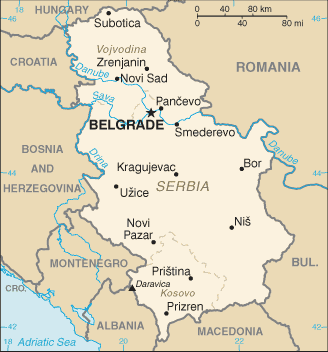 |
Mary's Rosaries |
| Home
Page Contact Us Make a Payment, Methods of Payment, Refund and Exchange Policies Rosaries subpages: How to Pray the Rosary subpages:
Pictures Main Page subpages: Curriculum subpages: Website Terms of Use License Agreement Sitemap The Work of God's Children |
Serbia
 The Kingdom of Serbs,
Croats, and Slovenes was formed in 1918; its name was changed to
Yugoslavia in 1929. Various paramilitary bands resisted Nazi Germany's occupation and division of
Yugoslavia from 1941 to 1945, but fought each other and ethnic
opponents as much as the invaders. The military and political movement
headed by Josip Tito (Partisans) took full control of Yugoslavia when
German and Croatian separatist forces were defeated in 1945. Although
Communist, Tito's new government and his successors (he died in 1980)
managed to steer their own path between the Warsaw Pact nations and the
West for the next four and a half decades. In 1989, Slobodan Milosevic
became president of the Serbian Republic and his ultranationalist calls
for Serbian domination led to the violent breakup of Yugoslavia along
ethnic lines. In 1991, Croatia, Slovenia, and Macedonia
declared independence, followed by Bosnia in 1992. The remaining
republics of Serbia and Montenegro
declared a new Federal Republic of Yugoslavia (FRY) in April 1992 and
under Milosevic's leadership, Serbia led various military campaigns to
unite ethnic Serbs in neighboring republics into a "Greater Serbia."
These actions led to Yugoslavia being ousted from the UN in 1992, but
Serbia continued its - ultimately unsuccessful - campaign until signing
the Dayton Peace Accords in 1995. Milosevic kept tight control over
Serbia and eventually became president of the FRY in 1997. In 1998, a
small-scale ethnic Albanian insurgency in the formerly autonomous
Serbian province of Kosovo provoked a Serbian counterinsurgency
campaign that resulted in massacres and massive expulsions of ethnic
Albanians living in Kosovo by FRY forces and Serb paramilitaries. The
Milosevic government's rejection of a proposed international settlement
led to NATO's bombing of Serbia in the spring of 1999 and to the
eventual withdrawal of Serbian military and police forces from Kosovo
in June 1999. UNSC Resolution 1244 in June 1999 authorized the
stationing of a NATO-led force (KFOR) in Kosovo to provide a safe and
secure environment for the region's ethnic communities, created a UN
interim Administration Mission in Kosovo (UNMIK) to foster
self-governing institutions, and reserved the issue of Kosovo's final
status for an unspecified date in the future. In 2001, UNMIK
promulgated a constitutional framework that allowed Kosovo to establish
institutions of self-government and led to Kosovo's first parliamentary
election. FRY elections in September 2000 led to the ouster of
Milosevic and installed Vojislav Kostunica as president. A broad
coalition of democratic reformist parties known as DOS (the Democratic
Opposition of Serbia) was subsequently elected to parliament in
December 2000 and took control of the government. The arrest of
Milosevic by DOS in 2001 allowed for his subsequent transfer to the
International Criminal Tribunal for the Former Yugoslavia in The Hague
to be tried for crimes against humanity. (Milosevic died at The Hague
in March 2006 before the completion of his trial.) In 2001, the
country's suspension from the UN was lifted, and it was once more
accepted into UN organizations. In 2003, the FRY became Serbia and
Montenegro, a loose federation of the two republics with a federal
level parliament. Widespread violence predominantly targeting ethnic
Serbs in Kosovo in March 2004 caused the international community to
open negotiations on the future status of Kosovo in January 2006. In
May 2006, Montenegro invoked its right
under the Constitutional Charter of Serbia and Montenegro to hold a
referendum on independence from the state union. The referendum was
successful, and Montenegro declared
itself an independent nation on 3 June 2006. Two days later, Serbia
declared that it was the successor state to the union of Serbia and Montenegro. In October 2006, the Serbian
parliament unanimously approved - and a referendum confirmed - a new
constitution for the country. Serbian is the official language;
Hungarian, Bosniak, and Romany are also spoken.
|
A "Safe for Souls" webpage. (this is the bottom of page) |